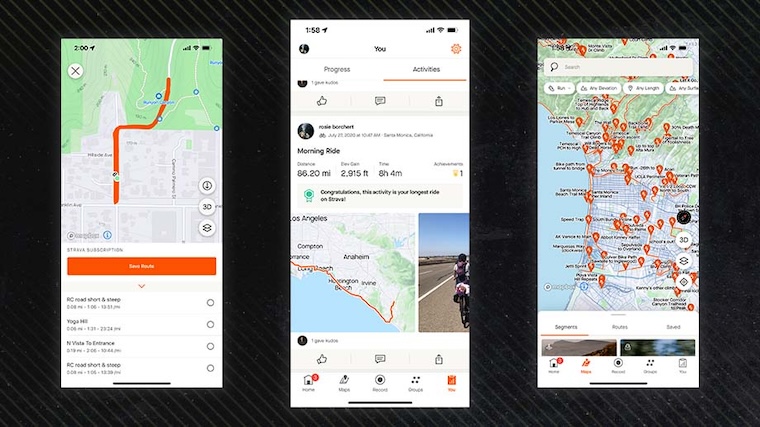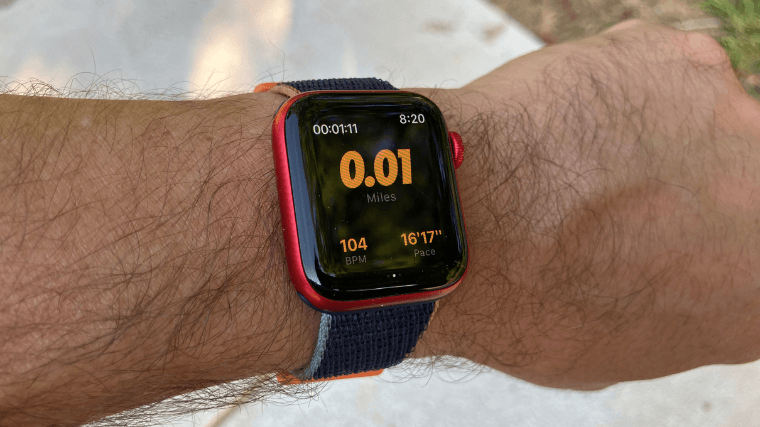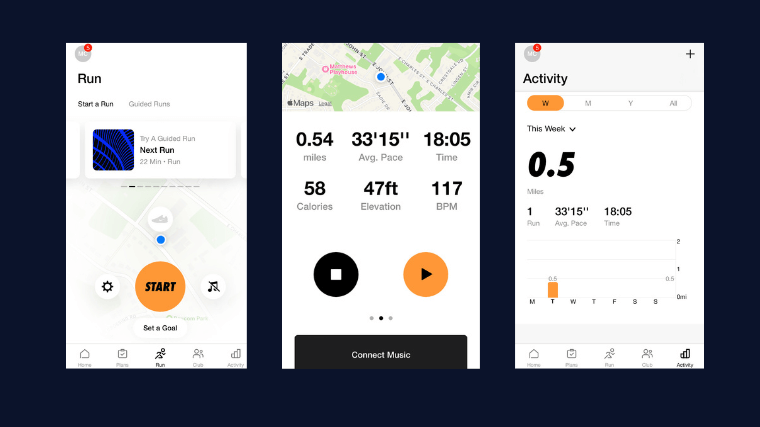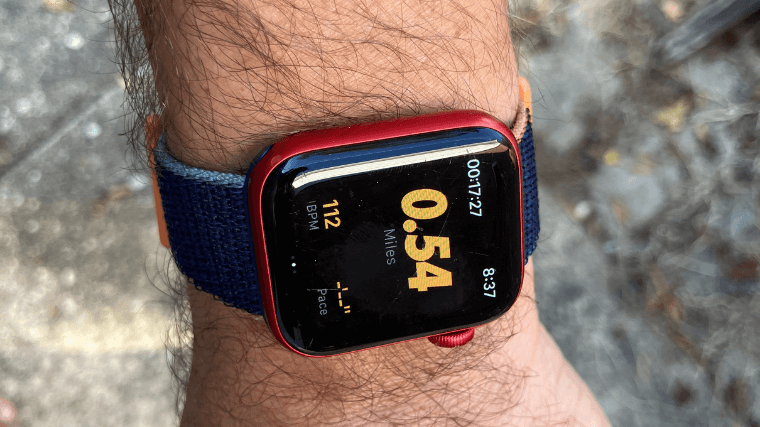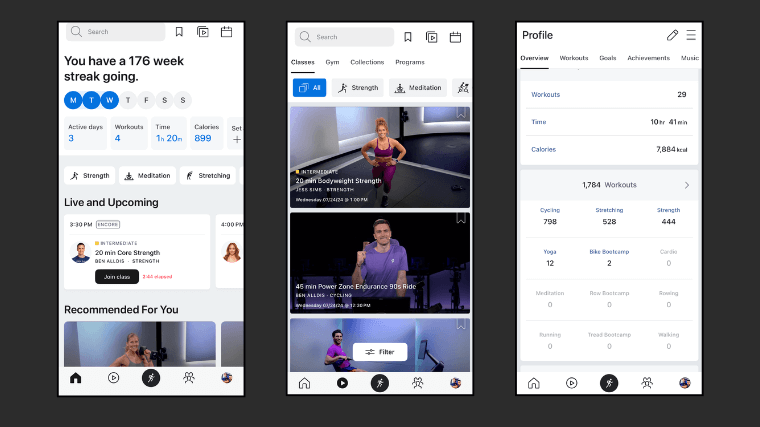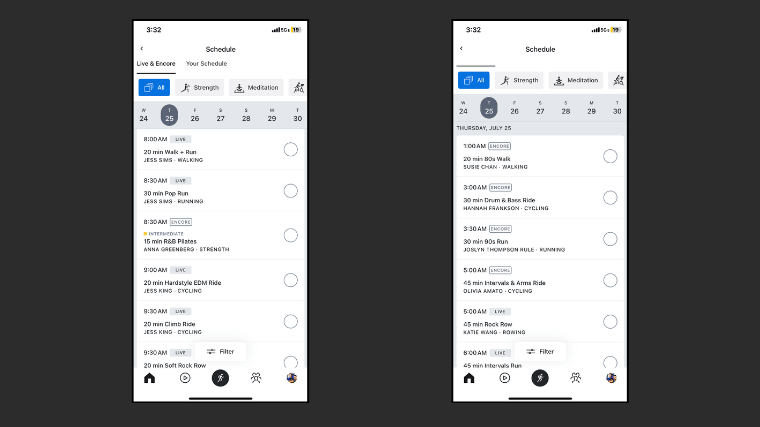Fitness often gets overcomplicated. You don’t need the best home gym equipment or any elaborate routines to get the benefits of moving your body. Walking — just walking — can do major things for your health. “Walking is a wonderful form of exercise that benefits cardiovascular health, mental health, and musculoskeletal health, among other things,” says BarBend expert reviewer and certified personal trainer Amanda Capritto. In fact, a 2023 analysis investigated worldwide walking habits and found that getting an extra 1,000 steps a day was associated with a 15% reduction in all-cause mortality risk. (1)
One way to motivate the habit? A walking app. There are many options out there that can track steps, mileage, routes, progress, and even stream workouts. To help you find the best one for your goals, peep our list of the best walking apps, which we’ve tested and can recommend for your next many, many steps.
The Best Walking Apps of 2025
- Best Overall Walking App: Strava
- Best Walking App for iPhone: iFIT
- Best Free Walking App: Nike Run Club
- Best Walking App for Weight Loss: MapMyWalk
- Best Indoor Walking App: Fitbit
- Best Walking App for Android: Pacer
- Best Walking App for Treadmill: Peloton
How We Tested and Chose the Best Walking Apps
Our BarBend team is made up of athletes, certified trainers, and workout obsessives, and we’ve tested more than 60 different fitness apps, including many for walking. To whittle down the field to these seven picks, we followed our tried-and-true testing methodology. That includes ranking each walking app on a scale of 1 (boo) to 5 (yay) based on important factors like instruction, accountability, and customer service. Here are a few aspects we paid special attention to when analyzing apps.
For more on how we test products, check out the BarBend equipment testing methodology.
- Compatibility: First and foremost, this includes whether or not an app is compatible with most smartphone operating systems. Second, however, is its ability to connect with smartwatches and wearables, which can really level up your experience with a walking app.
- Ease of Use: No one wants to watch a how-to tutorial before using an app; you just want to dive in and see how it works. We kept ease of use and user experience top of mind while reviewing these walking apps.
- Accountability: A big perk of any workout app is its influence on your routine — namely, keeping you accountable to continue logging workouts. Features like challenges, streak tracking, and community can help.
- Value: Many walking apps are free, though some require a monthly or annual subscription. We kept the price in mind while assessing features, to ultimately judge each app’s overall value.
Best Overall Walking App: Strava
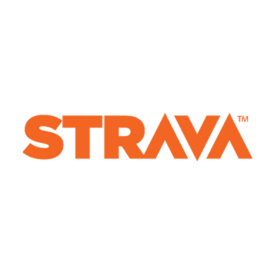
Popular with cyclists and runners for a reason, the Strava app can be an excellent tool for taking your running to the next level. With a social network, GPS tracking, and loads of data insights, this app is capable of tracking a wide array of physical activities.
Specs
- Free Option: Yes
- Price Per Month: $11.99
- Price Per Year: $79.99
- Compatibility: iOS and Android
I’ve been a Strava user for eight years now, and it’s long been my go-to tracking app for any and all outdoor workout activities, including walks. BarBend editorial member Randall Colburn is newer to the app, but equally as impressed, scoring it a 4 out of 5 overall. “It’s an extremely well-designed app that can help you discover new walking routes in your area and cultivate a community of local walkers if that’s something you’re into,” he says.
Using the app, you can find nearby walking routes and filter by elevation, difficulty, surface type, length, and more. Track your workout on your phone using GPS, or connect it to your smartwatch or heart-rate monitor and pull in your data later.
It’ll show you every metric you could possibly want (distance, pace, steps, calories, elevation gain — plus handy graphs) and even give you audio updates on distance and pace mid-walk. When you’re done, you can add a name, notes, photos, and videos, and post it onto your feed, deciding if you want the activity to be visible to friends, the public, or no one but you. If you need some motivation, try a challenge, race training plan, group or club (like “Hot Girl Walk”). This engaging, social atmosphere can help keep you accountable; Colburn scored it 4.5 out of 5 on accountability.
Strava can track 47 different activities, from surfing to cycling, so if you’re only planning to use the app to track walks, it could be overwhelming. “It may feel like overkill for those who simply want to use it for walking,” Colburn says. “There are a lot of customization options, and some people may just be looking for a step counter or something similar.” Still, he found it easy to understand, giving the app a 4 out of 5 for user experience.
Free Strava covers the basics, but upgrading will give you access to premium features like custom fitness goals and advanced analytics. Even if you join Strava for free just to walk, you could find yourself (like me) a paying subscriber years later, using the app to track all your adventures.
Best Walking App for iPhone: iFIT

The iFit app features a library of over 16,000 live and on-demand classes that range from mental health and recovery to rowing, running, HIIT and strength classes. You can get the full studio experience virtually through iFit, and is a great boost to any home gym set-up — with or without equipment.
Specs
- Free Option: No
- Price Per Month: Starting at $15-$39
- Price Per Year: Starting at $144
- Compatibility: iOS and Android
A word of warning: If you start using iFIT as a walking app, you might end up loving all its other workout classes as well. This workout streaming platform is particularly great for iPhone users, since it can automatically send data into the Health app and connect to your Apple Watch, so you can control your workout from your wrist as you walk. If you have one of the best treadmills with iFIT from NordicTrack or ProForm, you can also pull your walking data directly into the app and, with certain models, allow the app to auto-adjust your treadmill’s incline and resistance.
These fancy features might sound complicated, but our tester says, “The app was super easy to download and easy to use, just slightly less intuitive than other popular workout apps, in my opinion.” They scored it a 5 out of 5 for setup, and a 4.5 out of 5 for ease of use.
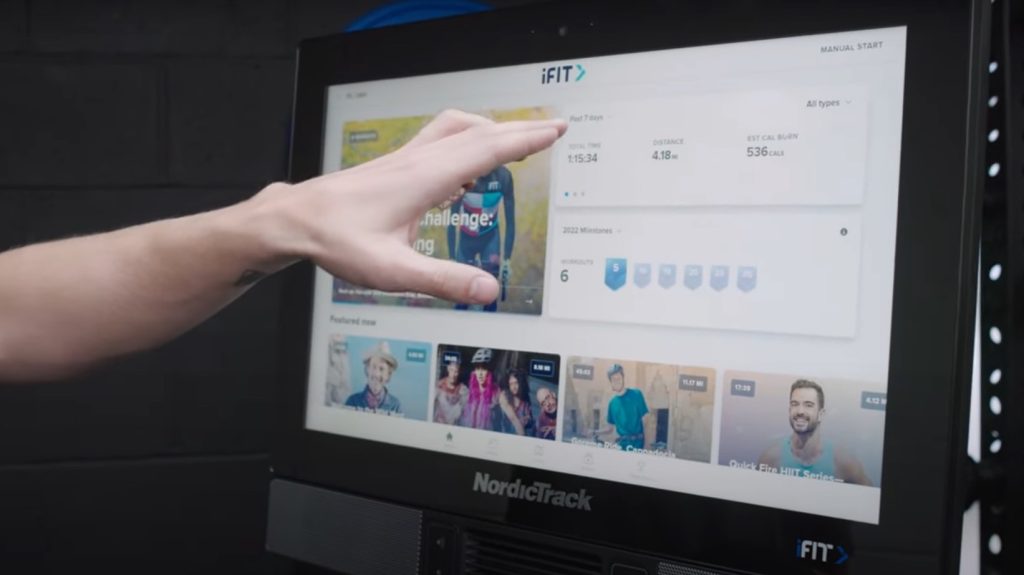
You can experience a few different types of walking workouts with iFIT. The app has both studio-style workout classes and immersive scenic classes that allow you to virtually walk, hike, run, or bike alongside one of their trainers. “I loved the outdoor classes; they were always my first choice,” says our tester, scoring iFIT 4.5 out of 5 for workout instruction. You can also cue up audio-only classes to walk outside.
As you might have noticed, iFIT is better if you’re looking for guided workouts rather than a simple app to track your miles and routes. If you’re looking for coached, entertaining workouts, and a dose of motivation, however, it could be a fit — and it comes at a pretty nice price, especially if you don’t have any connected equipment for streaming the workouts. Access to the app (without equipment connectivity) with their iFIT Train membership costs just $15 per month, which is why our tester gave it a 4 out of 5 for value.
Best Free Walking App: Nike Run Club
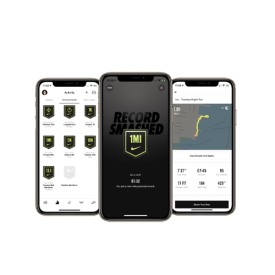
Set new running goals or just hit your weekly mileage with the free Nike Run Club app. You can try the app's race programs if you're preparing for your first 5K or go on a guided run with a Nike running coach.
Specs
- Free Option: Yes
- Price Per Month: N/A
- Price Per Year: N/A
- Compatibility: iOS and Android
If you’re on a budget or want a walking app that doesn’t push you to sign up for premium, peep Nike Run Club, which is 100% free. We previously named it one of the best running apps, but you can easily use it to track walks, too. (Speaking from experience, though, as someone who got hooked on NRC’s guided runs, their motivating content just might convince you to try a faster pace.)
BarBend editorial member Matt Cummings is also a fan, giving the app a 4.5 out of 5 for overall experience and a 5 out of 5 for user interface. “I love the Nike Run Club app. I used it years ago training for a half marathon, but as a walking app, it’s great,” he says. “The interface is where Nike Run Club really shines. It only takes a few taps to start a walk, then once you get going, you can swipe over to the controls or settings… It’s like they anticipate what someone is likely to want to turn on or off, and they make it easy to do so.” The app logs key metrics, plus your route, and has smartwatch compatibility with Garmin and Apple Watch for easy tracking on the move.
In addition to recording self-paced walks or runs, you can start a guided workout where you’ll be coached by a trainer (or even a pro runner) through pace adjustments, form checks, a warm-up and cooldown, etc. Though most of the 300 guided workouts are runs, there are also some walks and distance-based workouts you can complete at your own pace.
If you decide to give running a go, NRC offers beginner-friendly training plans to help you run a 5K, for example. “There are programs to follow and they are clearly laid out, making them easy to just tap and go,” Cummings says, giving it a 4 out of 5 for accountability. Additional features like challenges, achievement badges, and a leaderboard can stoke motivation and offer run-club vibes.
Best Walking App for Weight Loss: MapMyWalk
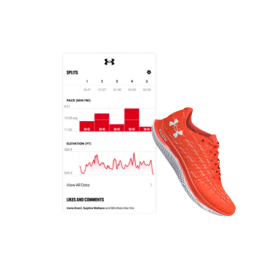
Whether you want community or to train alone (with your phone or smartwatch), Under Armour's MapMyWalk app supports both running and walking. The app lets you join challenges, access customized workouts and training plans, and collect your walking (or running) data to track progress.
Specs
- Free Option: Yes
- Price Per Month: $5.99
- Price Per Year: $29.99
- Compatibility: iOS and Android
If your main fitness goal is to lose weight, it can help to have an army of apps that help you attack it from all sides — namely, exercise and nutrition. If you want to try walking for weight loss and also track your macros, meals, or nutrition on the popular MyFitnessPal app, then MapMyWalk could be a good walking app for you. The two apps are partners, so you can share your data between them, giving you a better perspective on progress towards your weight loss goal.
MapMyWalk is part of Under Armour’s suite of fitness apps (including MapMyFitness, MapMyRide, and MapMyRun). Others are focused on running, cycling, and cross-training, while this one is geared toward walking. It offers a simple user interface, which our tester, certified personal trainer and BarBend editorial member Kate Meier, scored a 5 out of 5. “It’s incredibly straightforward. You open the app and hit ‘start workout,’” she says — that’s it.
“The app does have plans built-in, but they are mostly geared toward running… and a lot of the language is geared toward running, which is odd,” Meier said. As a result, she gave it a 2 out of 5 for programming, but a 5 out of 5 for overall experience. “It does what you need it to do: keeps track of your distance,” she says.
MapMyWalk also captures other basic metrics, like duration, elevation, and pace, and allows you to keep track of routes as well as find new ones nearby.
It has a social feed element, too, where you can connect with friends and share accomplishments, which could help with accountability and keep you consistent with your walks — something to consider if you’re walking with weight loss in mind.
Best Indoor Walking App: Fitbit

With the Fitbit app, you can monitor pretty much any stat you want — steps, stress level, sleep, and BPM. With the Fitbit app Premium, you'll get your own workouts, detailed information about your sleep and stress patterns, and mindfulness exercises that aren't available on the basic version.
Specs
- Free Option: Yes
- Price Per Month: $9.99
- Price Per Year: $79.99
- Compatibility: iOS and Android
A Fitbit fitness tracker can be super helpful in keeping an eye on your walking habits indoors or outdoors. But you don’t necessarily need an extra device to track your steps — all you need is your smartphone and the Fitbit app.
It uses your phone’s built-in sensors to estimate the amount of steps you’ve taken and distance covered. As long as you carry your phone with you, your daily steps and mileage will be instantly captured. Admittedly, that can also be a downside. If you forget your phone when leaving the house, or aren’t in the habit of bringing it from room to room while at home, it won’t give you a truly accurate picture of how much you’re walking.
That said, the Fitbit app does much more than just count your steps. It’s like a one-stop shop for all health-habit tracking; you can manually log your workouts, food and water intake, sleep, weight, menstrual cycle, mindfulness sessions, and more.
The workout logging feature includes the ability to track walks, runs, hikes, and bike rides in real time right in the app. Just hit “start exercise,” and it collects data on your route, distance, pace, and calories burned — making it a great walking app for tracking outdoor walks just as much as indoor ones. “There’s a community on the app, too. You can connect with news, local events, friends, and join groups, like ‘cardio’ or ‘snacking tips’ with millions of other members,” our tester said.
The app is bright and anything but busy, which makes navigation simple even without any instruction, earning it a 5 out of 5 for user interface. I was able to set up an account, link it to my iPhone’s Health app, and start a walking workout in a matter of minutes.
Believe it or not, it’s all totally free, too, which is why it earned a 5 out of 5 for value. You can upgrade to the Premium subscription ($9.99 a month) for access to guided workouts and mindfulness sessions led by instructors, but everything else is available in the free version.
Best Walking App for Android: Pacer
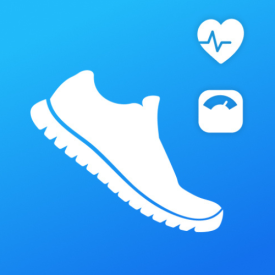
The Pacer app works like a pedometer, tracking your steps to help ensure you're getting enough movement each day.
Specs
- Free Option: Yes
- Price Per Month: $9.99
- Price Per Year: $49.99
- Compatibility: iOS and Android
FYI, you don’t need to buy one of the best pedometers to track your steps —an app on your iOS or Android mobile device can do it for you. Pacer is a simple pedometer and GPS-tracking walking app that you can use to track your steps, runs, walks, and rides. As long as you have your phone with you during the day, it’ll track your steps using your device’s built-in sensors, giving you a sense of how much distance you cover and how often you move. In just a couple of taps, you can also start tracking an outdoor walk or other activity.
“I’ve tried about nine of these pedometer apps, and so far this is the best,” writes one reviewer in the Google Play app store. “The two biggest problems with most of them are constant (and unclosable) ads. Pacer has very few of these. The other problem is that most of these apps award me far more steps than I’ve actually taken (yes, I counted steps carefully). Pacer does give me a few extra steps each time, but way less than the 6% to 10% error rate I’ve found on other apps. The free version doesn’t have a lot of bells and whistles, but that’s OK.”
Pacer premium unlocks extra features like AI coaching, extra video workouts, fitness plans, and more, though the features that make it a great walking app are right there in the free version. Reviewers enjoy the challenges, leaderboards, streak feature, and ability to create groups with family and friends and compete for the most steps. “Great app for tracking your steps, your route, or adding a distance manually to one of their many virtual challenges,” another reviewer writes. “I have earned several medals, and they keep me motivated to stay active.”
Best Walking App for Treadmill: Peloton
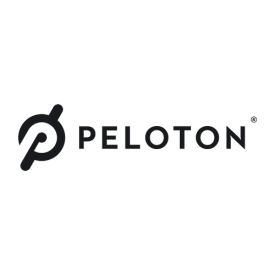
No need to have Peloton equipment when you can have access to the app with a subscription. Take classes from popular coaches to help you get your run done and dusted.
Specs
- Free Option: No
- Price Per Month: Starting at $12.99
- Price Per Year: Starting at $129
- Compatibility: iOS and Android
Peloton may be known for cycling, but their treadmill classes hit just as hard — and that includes walking workouts. They offer several types, including power walks, music-driven classes, walk/runs, and hikes (aka incline training, my personal favorite treadmill workout from Peloton). “You can choose from workouts with varying levels of difficulty, which I like because you can do a gentler one to just move your body or a full-on workout if you feel like challenging yourself,” our tester said, giving Peloton a 5 out of 5 for overall experience.
If you’re taking a break from the tread because the weather’s nice, you can also take the app outside with their audio-only workouts. The playlists and coaching are just as excellent as their studio sessions — our tester gave the app a 4.5 out of 5 for instruction. During an outdoor walk, the app pulls in your data, including your GPS route, pace, splits, and elevation gain.
“There isn’t much room for customization, but you can see details about each class before you start, which allows you to personalize your experience. For example, if you like a certain type of music or there’s an exercise you want to avoid, you could easily pick a class that fits your preferences,” our tester said, giving it a 5 out of 5 for user interface.
With that in mind, using the Peloton app, “you wont be able to just mindlessly walk” our tester added. This isn’t a workout for tracking your own self-guided walks, but for following trainer-led walking workouts.
Worth noting: With Peloton’s App One membership ($12.99 a month), you can only take three cardio equipment classes per month, so if you want to use Peloton on the tread, you’ll need to upgrade to App+ ($24 a month) or All-Access ($44 a month) for unlimited access to cardio classes. (The even higher prices only come into play if you own a Peloton treadmill or Bike.)
“I like Peloton because of the way I feel after working out, mentally and physically,” our tester said. “Exercise is framed in such a positive way, where you’re pushed and encouraged at the same time.”
Benefits of Walking Apps
You might be sold on the many benefits of walking for wellness — but what about walking apps? For starters, they can help improve your overall workout experience, and keep you coming back. Here are some of the other benefits of using a walking app instead of raw-dogging your next stroll.
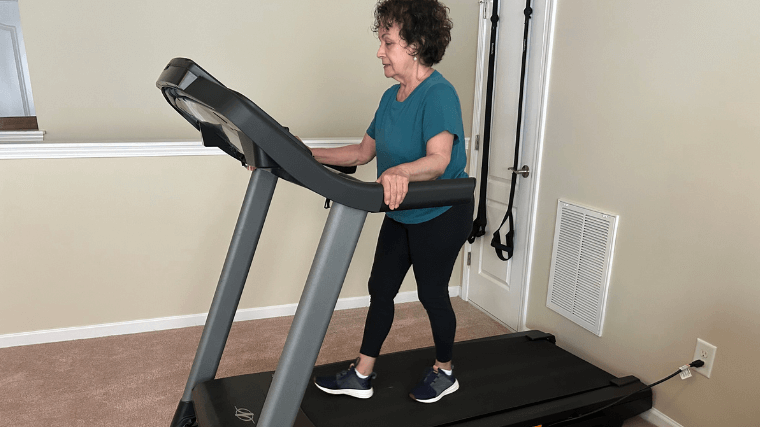
- Track Metrics: Seeing your weekly, monthly, or lifetime mileage creep up over time can offer a sense of achievement and keep you coming back. Research shows that fitness tracking, in general, has a positive effect on users’ motivation to keep up physical activity, such as walking. (2)
- Training Plans: Many walking apps offer training programs, which can help take the guesswork out of planning your own workouts and give you a schedule to follow and goal to work toward.
- Discover New Walking Routes: Many walking apps allow you to discover new walking and hiking routes near home or while you’re traveling. Others (namely, those that stream workouts) allow you to virtually explore the world while walking on a treadmill — and without leaving your house.
- Accountability: “People who struggle with accountability can benefit from workout apps,” says Amanda Capritto, our expert reviewer and a certified personal trainer. “They’re a great way to hold yourself accountable and keep showing up for yourself.”
- Entertainment: Walking apps that offer entertainment while you walk can help make being active more enjoyable, and enjoyment can strongly influence someone’s likelihood of continuing to exercise. (3) Translation: Having fun means you’re more likely to do it again, which can help you stick with your workout routine.
How Much Do Walking Apps Cost?
You can get a basic walking app that tracks steps, routes, and mileage totally free. To level up, you’ll need to pay a little more ($5 to $15 per month) for additional features, or spend $13-$40 for one that streams follow-along walking workouts (plus, many more modalities).

| Best Overall Walking App | Strava | Free; $11.99/month; $79.99/year |
| Best Walking App for iPhone | iFIT | $15-$39/month; $144-$396/year |
| Best Free Walking App | Nike Run Club | Free |
| Best Walking App for Weight Loss | MapMyWalk | Free; $5.99/month; $29.99/year |
| Best Indoor Walking App | Fitbit | Free; $9.99/month; $79.99/year |
| Best Walking App for Android | Pacer | Free; $9.99/month; $49.99/year |
| Best Walking App for Treadmill | Peloton | $12.99-$44/month; $129-$528/year |
What to Consider Before Buying a Walking App
Before you go all-in on an annual subscription to one of these walking apps, consider the following factors. They’ll help you decide which one might be best for you — before you shell out any cash.
Fitness Goals
What do you hope to accomplish with a walking app? Do you want to find new places to walk, keep a log of previous routes, track mileage, or just count your daily steps? This will help massively in deciding the best fitness app for you.
“Fitness apps help guide you to reach your goals,” says Amanda Capritto, our expert reviewer and a certified personal trainer. “They keep you on track and serve as a form of accountability… They can keep fitness fun and interesting, expose you to types of training you may not have thought of yourself, and at the same time, keep things simple so you don’t get distracted by all of the noise around fitness online.”
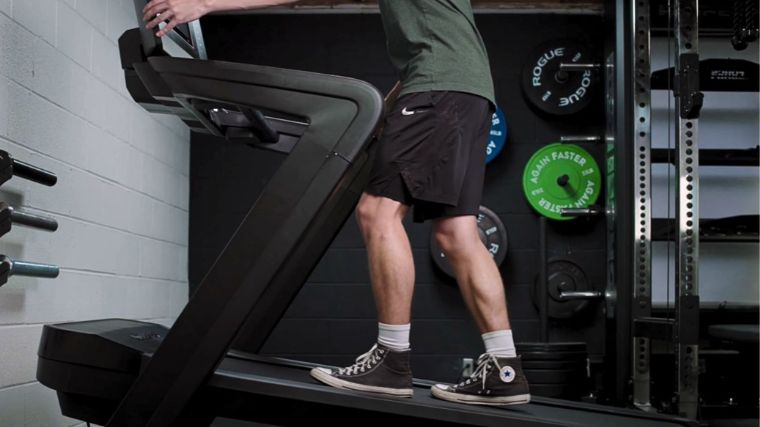
Of course, if you’re not looking for that much support, a walking app can also just count your steps.
User Experience
Consider what sort of interactivity you’re looking for in a walking app. Do you want a simple tracking screen, with basic stats like miles walked and steps taken? Do you want to be able to track other types of workouts, too? Are you looking for workout plans or coached walking workouts to stay challenged? How about social support — do you want a community feed, or privacy? These are all important questions to consider when deciding what type of experience you want with a walking app.
Compatibility
Of course, you’ll want to make sure a walking app is compatible with your phone’s operating system, but most apps these days (and all the ones listed here) are available on both iOS and Android, so that shouldn’t be a problem. More important is considering any additional devices you want your walking app to play nicely with, including a smartwatch, fitness tracker, heart rate monitor, or connected fitness equipment, like one of the best treadmills with screens. If you have a Fitbit device, their app is a natural fit for tracking walks and steps. Other walking apps, like Strava, have extensive connectivity with other devices of all kinds.
Walking Apps FAQs
What is the best walking app?
Strava gets our pick for the best walking app overall thanks to a few standout features: in-depth activity and GPS tracking, regular challenges, community engagement, easy connectivity with other devices, and a heatmap for finding new routes. That said, it may be feature overkill if you’re just looking for a simple way to track your mileage or steps (in that case, Fitbit or Pacer might be better). And if you’re looking to stream walking workouts outdoors or on the treadmill, let us suggest iFIT or Peloton instead.
Do walking apps work for weight loss?
They might. Research shows that smartphone apps and activity trackers do indeed promote more physical activity in people who use them, though that doesn’t always translate to weight loss, since there are so many other factors (diet, age, genetics, etc.) involved. (4)(5) For example, a 2022 study examined the effects of a smartphone pedometer app over about seven months and found that it increased physical activity but didn’t lead to weight loss. That said, walking certainly has the potential to help with weight loss efforts. A 2017 review of 22 research studies found that brisk walking can create a clinically significant reduction in body weight, BMI, waist circumference, and fat mass for obese men and women under 50 years old. (6)
How many miles is 10,000 steps?
If you’re walking, it will take approximately 2,100 steps to cover a mile, which means that 10,000 steps are equivalent to almost 5 miles (4.76, to be exact). However, the distance you cover with each step also depends on your height and stride length, which means that the exact number of steps in a mile for you may be a slightly different number.
References
- Banach, M., Lewek, J., Surma, S., Penson, P. E., Sahebkar, A., Martin, S. S., Bajraktari, G., Henein, M. Y., Reiner, Ž., & Bytyçi, I. (2023). The association between daily step count and all-cause and cardiovascular mortality: A meta-analysis. European Journal of Preventive Cardiology, 30(18), 1975-1985. https://doi.org/10.1093/eurjpc/zwad229
- Jin, D., Halvari, H., Maehle, N., & Olafsen, A. H. (2020). Self-tracking behaviour in physical activity: a systematic review of drivers and outcomes of fitness tracking. Behaviour & Information Technology, 41(2), 242–261. https://doi.org/10.1080/0144929X.2020.1801840
- Teixeira, D. S., Rodrigues, F., Cid, L., & Monteiro, D. (2022). Enjoyment as a Predictor of Exercise Habit, Intention to Continue Exercising, and Exercise Frequency: The Intensity Traits Discrepancy Moderation Role. Frontiers in psychology, 13, 780059. https://doi.org/10.3389/fpsyg.2022.780059
- Laranjo, L., Ding, D., Heleno, B., Kocaballi, B., Quiroz, J. C., Tong, H. L., Chahwan, B., Neves, A. L., Gabarron, E., Dao, K. P., Rodrigues, D., Neves, G. C., Antunes, M. L., Coiera, E., & Bates, D. W. (2021). Do smartphone applications and activity trackers increase physical activity in adults? Systematic review, meta-analysis and metaregression. British journal of sports medicine, 55(8), 422–432. https://doi.org/10.1136/bjsports-2020-102892
- National Center for Biotechnology Information. (2010). Genomics and health care. National Institutes of Health. https://www.ncbi.nlm.nih.gov/books/NBK221834/
- Mabire, L., Mani, R., Liu, L., Mulligan, H., & Baxter, D. (2017). The Influence of Age, Sex and Body Mass Index on the Effectiveness of Brisk Walking for Obesity Management in Adults: A Systematic Review and Meta-Analysis. Journal of physical activity & health, 14(5), 389–407. https://doi.org/10.1123/jpah.2016-0064
